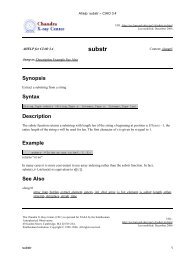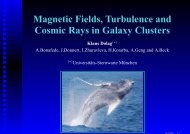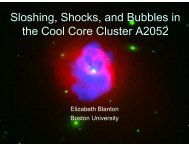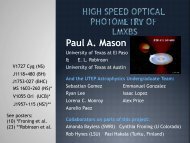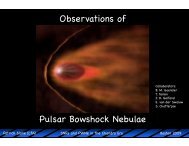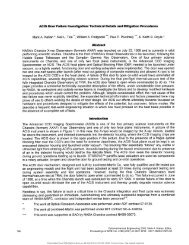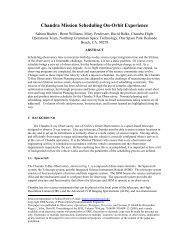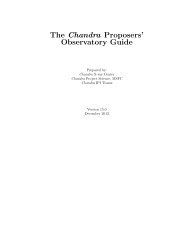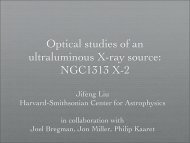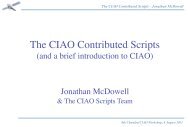PDF Version - Chandra X-Ray Observatory (CXC)
PDF Version - Chandra X-Ray Observatory (CXC)
PDF Version - Chandra X-Ray Observatory (CXC)
Create successful ePaper yourself
Turn your PDF publications into a flip-book with our unique Google optimized e-Paper software.
8<br />
Project Manager’s Report<br />
Roger Brissenden<br />
<strong>Chandra</strong> marked over twelve years of successful mission<br />
operations with continued excellent operational and<br />
scientific performance. Telescope time remained in high<br />
demand, with significant oversubscription in the Cycle 13<br />
peer review held in June. In the Fall the observing program<br />
transitioned from Cycle 12 to Cycle 13. We released the Call<br />
for Proposals for Cycle 14 in December, and look forward<br />
to the Cycle 14 peer review in June 2012.<br />
The team worked hard to prepare for NASA’s 2012<br />
Senior Review of operating missions. The <strong>CXC</strong> submitted<br />
our proposal in January 2012 (with the Education and Public<br />
Outreach proposal submitted separately in December,<br />
2011), and will participate in an oral presentation to the Senior<br />
Review committee at the end of February 2012.<br />
The <strong>CXC</strong> conducted several workshops and symposia<br />
during 2011. We celebrated <strong>Chandra</strong>’s 12th anniversary<br />
with the symposium “12 Years of Science with <strong>Chandra</strong>,”<br />
part of the American Astronomical Society meeting<br />
held in Boston in May. In July we conducted the workshop<br />
“Structure of Clusters and Groups of Galaxies in the <strong>Chandra</strong><br />
Era,” and in August held the 2011 5-day X-ray Astronomy<br />
School, followed by a workshop for users of the <strong>CXC</strong>’s<br />
CIAO data analysis software system. As part of the <strong>CXC</strong>’s<br />
regular reviews and consultations with outside organizations,<br />
NASA reviewed the <strong>CXC</strong>’s operations in March and<br />
September, and the <strong>Chandra</strong> Users’ Committee met at the<br />
<strong>CXC</strong> in October.<br />
The <strong>CXC</strong> mission planning staff continued to<br />
maximize observing efficiency in spite of temperature constraints<br />
on spacecraft pointing. Competing thermal constraints<br />
continue to require that some longer observations<br />
be split into multiple short duration segments, to allow<br />
the spacecraft to cool at preferred attitudes. The total time<br />
available for observing has been increasing gradually over<br />
the past few years as <strong>Chandra</strong>’s orbit evolves and the spacecraft<br />
spends less time in Earth’s radiation belts. The overall<br />
observing efficiency during 2011 was 75%, compared with<br />
74% in 2010 and an average of 68% over the mission. In the<br />
next several years we expect potential<br />
observing time to increase slightly, but actual observing to<br />
be limited by radiation due to increasing solar activity.<br />
Operational highlights over the past year included<br />
five approved requests to observe targets of opportunity<br />
that required the mission planning and flight teams to interrupt<br />
and revise on-board command loads. After several<br />
years of very low solar radiation, the sun has become more<br />
active, causing the team to interrupt <strong>Chandra</strong> observing<br />
<strong>CXC</strong> Newsletter<br />
three times during the year to protect the instruments from<br />
solar particles. <strong>Chandra</strong> passed through the 2011 summer<br />
and winter eclipse seasons, as well as a brief lunar eclipse in<br />
June, with nominal power and thermal performance.<br />
<strong>Chandra</strong>’s first full safe mode event in over 11<br />
years—ultimately shown to have no hardware cause—occurred<br />
in July. On-board software detected an anomalous<br />
change in the spacecraft’s angular momentum, triggering<br />
an autonomous transition to safe mode and a resulting<br />
swap to redundant hardware. The swap went flawlessly<br />
and all of the redundant systems performed as expected.<br />
The <strong>CXC</strong>’s flight and science staff changed immediately to<br />
24-hour operations and scheduled extra telemetry contacts<br />
with the spacecraft. Analysis of spacecraft data and orbital<br />
dynamics revealed that the safe mode transition resulted<br />
from a complex interaction of gravity-gradient torques,<br />
commanding in the science loads, and flight software timing.<br />
No hardware failures were involved and no harm was<br />
caused to the <strong>Observatory</strong>. The staff returned <strong>Chandra</strong> to<br />
nominal observing five days after the anomaly occurred,<br />
with a loss of 370 ks of observing time. The event demonstrated<br />
the training, effectiveness and seamless cooperation<br />
of all elements of the <strong>Chandra</strong> X-ray <strong>Observatory</strong> team.<br />
In October, the spacecraft transitioned to normal<br />
sun mode when an electronic circuit reset, believed to be<br />
due to a single event upset, in which radiation or ions interrupt<br />
a component in the on-board electronics. The operations<br />
teams returned the spacecraft to normal status within<br />
two days with no adverse consequences, but the loss of 154<br />
ks of observing time.<br />
As part of an on-going risk reduction program, the<br />
<strong>CXC</strong> flight team identified a method to improve <strong>Chandra</strong>’s<br />
response to high radiation as the sun becomes more active.<br />
The new process maintains the science instruments<br />
in a radiation-safe condition while allowing controllers to<br />
continue spacecraft management activities such as eclipse<br />
response, attitude control, and thermal and momentum<br />
management. The new safing approach reduces risk to the<br />
spacecraft and minimizes the time and effort required to<br />
resume observations after a high radiation event. Following<br />
software development and extensive ground testing, the<br />
new method was fully implemented on 1 December 2011<br />
and first came into action during a radiation safing in January,<br />
2012.<br />
Both focal plane instruments, the Advanced CCD<br />
Imaging Spectrometer and the High Resolution Camera,<br />
have continued to operate well and have had no significant<br />
problems. ACIS, along with the overall spacecraft, has continued<br />
to warm gradually.<br />
All systems at the <strong>Chandra</strong> Operations Control<br />
Center continued to perform well in supporting flight operations.



